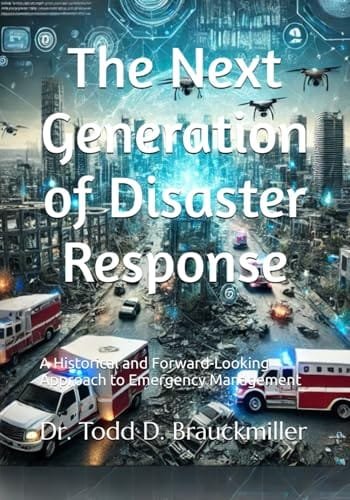
Drones have become crucial in disaster relief efforts. They offer rapid response and efficient resource management during emergencies.
Disaster scenarios demand quick action and precise coordination. Drones play a vital role in bridging gaps during such crises. They provide aerial views, helping responders assess situations effectively. This technology aids in delivering supplies and conducting searches in hard-to-reach areas.
Drones equipped with Geographic Information Systems (GIS) enhance mapping and planning, crucial for efficient disaster management. They help manage resources and minimize risks by offering real-time data. Understanding their role in handling terrorism and weapons of mass destruction (WMDs) scenarios is vital too. As technology advances, drones will continue to be indispensable tools in emergency management, ensuring faster, safer, and more effective disaster relief operations.
The Next Generation Of Disaster Response: A Historical And Forward-looking Approach To Emergency Management

The ideal customer for “The Next Generation of Disaster Response: A Historical and Forward-Looking Approach to Emergency Management” includes emergency management professionals, policy makers, and academics interested in gaining a comprehensive understanding of both historical and modern approaches to disaster response. Individuals seeking to enhance their knowledge and skills in emergency preparedness will find this book invaluable.
Pros:
- Provides a comprehensive overview of historical and modern disaster response strategies.
- Independently published, ensuring an unbiased perspective.
- Compact and accessible size with dimensions suitable for easy handling.
- Offers 168 pages of detailed content, ideal for in-depth study.
- Forward-looking approach to emergency management practices.
Cons:
- Limited to 168 pages, which may not cover every aspect in depth.
- Publication date set in the future (2025), making it currently unavailable.
The book’s detailed exploration of historical disaster responses provides readers with a foundation to understand the evolution of emergency management. By examining past events, readers can glean insights into what strategies were effective and how they can be adapted for future challenges. This historical context is crucial for those in the field, as it highlights both successes and failures in past approaches.
Furthermore, the forward-looking aspect of the book offers innovative solutions and methodologies that can be integrated into current emergency management practices. By focusing on future trends and potential developments, the book equips readers with the foresight needed to anticipate and prepare for emerging threats. This makes it an essential read for anyone involved in the creation or implementation of disaster response strategies.
To buy this product, click here.
Terrorism And Wmds

The ideal customer for Terrorism and WMDs is someone deeply invested in understanding the complex interplay between terrorism and weapons of mass destruction. This item is perfect for academics, policy makers, and security professionals who require a comprehensive resource for analyzing global security threats. Individuals pursuing studies in political science, international relations, or homeland security will find this book invaluable.
Pros:
- Comprehensive coverage of terrorism and WMDs.
- Expert insights from leading professionals in the field.
- Detailed analysis of historical and contemporary cases.
- Structured format that aids in easy understanding.
Cons:
- Complex language might be challenging for beginners.
- Dense content may require dedicated time for thorough reading.
The book Terrorism and WMDs offers a meticulous examination of how weapons of mass destruction intersect with terrorist strategies. It delves into the historical context of these threats, providing readers with a solid foundation to understand the evolution of such tactics over time. By presenting a multidimensional approach, it equips users with the knowledge to anticipate potential scenarios and formulate effective countermeasures.
One of the key features is its in-depth case studies that highlight real-world examples of terrorism involving WMDs. These cases are analyzed thoroughly, offering insights into motivations, methods, and outcomes. Readers gain a better understanding of how international policies can be shaped to prevent future incidents. Additionally, the book’s structured format ensures that complex concepts are broken down into manageable sections, enhancing the reader’s comprehension and retention.
To buy this product, click here.
Geographic Information Systems (gis) For Disaster Management

Geographic Information Systems (GIS) for Disaster Management is a comprehensive resource designed for professionals in disaster management, emergency response teams, and urban planners who seek to enhance their capabilities in managing and mitigating the impacts of natural and human-made disasters. This book is ideal for those who are looking to integrate advanced technology into their disaster management strategies to improve decision-making and resource allocation during crises.
Pros:
- Provides in-depth insights into GIS applications for disaster management.
- Enhances decision-making capabilities with spatial data analysis.
- Improves coordination among emergency response teams.
- Offers practical examples and case studies for real-world application.
Cons:
- May require prior knowledge of GIS technology for effective utilization.
- Focuses heavily on technical aspects, which might be challenging for beginners.
- The publication date is 2014, so it might not include the latest advancements in GIS technology.
The book delves deeply into the technical aspects of Geographic Information Systems, offering readers a comprehensive understanding of how GIS can be employed to address various challenges in disaster management. It covers a wide range of topics including data collection, analysis, and visualization, which are crucial for effective disaster planning and response. By leveraging GIS technology, users can predict potential disaster scenarios, optimize resource allocation, and coordinate emergency services more effectively, leading to better outcomes during critical situations.
One of the standout features of this book is its focus on real-world applications of GIS technology. It provides case studies and examples that demonstrate the practical implementation of GIS in disaster scenarios, helping readers to grasp the benefits of integrating GIS into their management strategies. By understanding how GIS can be used to visualize and analyze spatial data, professionals can enhance their strategic planning and ensure that resources are allocated efficiently during emergencies. This not only improves response times but also minimizes the impact of disasters on affected communities.
To buy this product, click here.
Terrorism And Wmds: Awareness And Response

The ideal customer for “Terrorism and WMDs: Awareness and Response” is a security professional, emergency responder, or policy maker who seeks a comprehensive understanding of terrorism and weapons of mass destruction (WMDs). This book is also valuable for academics and students pursuing studies in homeland security, public safety, and international relations.
Pros:
- Comprehensive coverage of terrorism and WMDs.
- Authored by experts from CRC Press, known for their authoritative publications.
- Updated edition with the latest strategies and insights.
Cons:
- Complex content may be challenging for readers without a background in security studies.
- Technical terminology might require additional research for full understanding.
This book’s detailed examination of terrorism and WMDs makes it an essential resource for those responsible for national security and emergency preparedness. The third edition includes the latest developments and strategies, ensuring readers are well-equipped with current information. With its publication by CRC Press, a trusted name in academic and professional resources, the book assures credibility and reliability in its content.
The substantial 458 pages provide an in-depth look at potential threats and response strategies, making it indispensable for emergency responders who need to be thoroughly prepared for potential crises. The book’s dimensions and weight are designed for ease of handling, making it a practical addition to any professional’s library. Overall, this book serves as a comprehensive guide for understanding and responding to the complex challenges posed by terrorism and WMDs.
To buy this product, click here.
Geographic Information Systems (gis) For Disaster Management

Geographic Information Systems (GIS) for Disaster Management is an essential resource for professionals in the field of emergency management, urban planning, and environmental science. Ideal for those who need to understand and implement GIS technology to enhance disaster preparedness and response strategies. This book is perfect for academics, government officials, and consultants looking to leverage GIS in mitigating disaster impacts.
Pros:
- Comprehensive coverage of GIS applications in disaster management.
- Updated edition with the latest case studies and examples.
- Extensive resources and references for further research.
Cons:
- Complex concepts may require prior GIS knowledge.
- Hefty volume might be overwhelming for beginners.
This book provides a detailed analysis of how GIS technology can be utilized effectively in disaster management. With its 482 pages, it offers a thorough exploration of GIS methodologies, allowing users to integrate spatial data into their disaster preparedness plans. The second edition ensures readers have access to current practices and recent advancements in the field, making it a valuable tool for professionals seeking up-to-date information.
Furthermore, the publication from Routledge is known for its quality and credibility, ensuring that readers are accessing reliable content. The case studies included in the book demonstrate real-world applications, providing users with practical insights into how GIS can enhance their work. The benefits of using GIS as outlined in this book include improved risk assessment and resource allocation, critical for effective disaster management strategies.
To buy this product, click here.
Frequently Asked Questions
How Do Drones Aid In Disaster Relief?
Drones offer rapid aerial assessments, providing real-time data during disasters. They can reach inaccessible areas, delivering supplies or surveying damage. This enhances emergency response efficiency. Equipped with cameras and sensors, drones help locate survivors and map affected regions swiftly, improving coordination efforts in disaster management.
What Role Does Gis Play In Disaster Management?
Geographic Information Systems (GIS) help visualize and analyze spatial data. In disaster management, GIS supports planning and response efforts by mapping risk areas. It aids in tracking disaster impact, optimizing resource allocation, and improving communication. GIS enhances decision-making processes, enabling more effective disaster relief strategies.
Why Is Awareness Crucial For Terrorism Response?
Awareness helps identify potential threats and vulnerabilities early. It enables individuals and organizations to prepare and respond effectively to terrorism incidents. Awareness programs educate on recognizing warning signs and implementing preventive measures. Enhanced awareness can reduce risks and improve safety during terrorism-related emergencies.
How Can Drones Improve Emergency Management?
Drones enhance emergency management by providing aerial views and data collection. They support search and rescue operations, assess damage, and deliver supplies. Drones offer quick deployment, reducing response times. Their ability to navigate difficult terrains makes them invaluable in challenging environments, improving overall disaster response.
What Is The Future Of Disaster Response Technology?
Future disaster response technology will involve more advanced drones and data analytics. These will offer improved real-time insights and faster deployment capabilities. Integration with AI and machine learning will enhance predictive analysis. This will lead to better preparedness and more efficient resource allocation during emergencies.
Conclusion
Drones are becoming crucial in disaster relief efforts. They provide real-time data and support emergency teams efficiently. Their ability to access hard-to-reach areas ensures faster response times. This technology can help save lives and protect communities. Drones equipped with cameras and sensors offer valuable insights.
They map affected regions and assess damage quickly. Important for planning and recovery. Geographic information systems (gis) enhance the effectiveness of drones. They provide detailed maps and data analysis. This aids emergency personnel in making informed decisions. Terrorism and wmds require swift and accurate responses.
Drones offer surveillance and assessment capabilities in such scenarios. Essential for public safety. As technology advances, drones will play an even greater role. Emergency management will benefit from innovative solutions. Their future in disaster relief looks promising. Communities must prepare and invest in this technology.
For a safer tomorrow.







